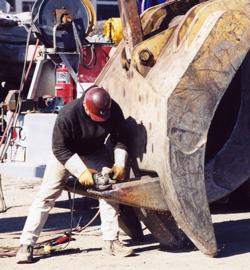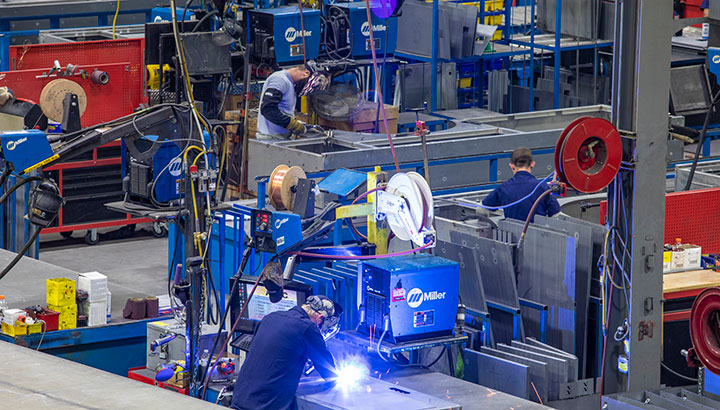Typical Welding Fixing Issues and How to Address Them Efficiently
Welding repairs usually experience a variety of concerns that can endanger the stability of the end product. Typical problems include insufficient infiltration, porosity, and imbalance, amongst others. Each problem offers special difficulties that need particular techniques for resolution. Recognizing these problems is necessary for welders intending to enhance their skills and outcomes. This discussion will certainly discover these usual welding repair service issues and reliable methods to address them.
Inadequate Infiltration
Inadequate penetration occurs when the weld metal falls short to completely fuse with the base material, leading to weak joints and prospective structural failures. This problem commonly originates from insufficient heat input, incorrect electrode angle, or incorrect welding speed. Welders may encounter inadequate infiltration because of a mistake of the needed criteria for a certain material density or kind. Additionally, contamination on the base product's surface can prevent reliable bonding, aggravating the problem. To attend to poor infiltration, welders must guarantee appropriate settings on their devices and preserve a clean work surface area. Normal assessment of welds is suggested to identify any kind of shortages early, allowing for timely improvements and the avoidance of jeopardized architectural integrity in welded settings up.
Porosity
Porosity is an usual flaw in bonded joints that materializes as tiny gas bubbles trapped within the weld steel. This defect can endanger the stability of the weld, bring about minimized strength and prospective failing under tension. Montana Mobile Welding and Repair Fabrication. Porosity generally arises from contamination, moisture, or improper welding techniques, which enable gases to get away right into the liquified weld swimming pool. To address porosity, welders must ensure proper surface area preparation, preserve a tidy functioning setting, and use ideal welding criteria. Additionally, choosing the appropriate filler material and shielding gas can minimize gas entrapment. Normal examination and screening of welds can assist identify porosity early, ensuring prompt corrective activities are taken, thereby preserving the high quality and dependability of the bonded structure
Misalignment
Misalignment in welding can emerge from numerous variables, including incorrect setup and thermal development. Recognizing the root creates is necessary for effective resolution. Several modification techniques are offered to straighten components and guarantee structural stability.
Reasons for Misalignment
Welding misalignment frequently originates from a range of underlying concerns that can jeopardize structural honesty. One primary cause is inappropriate fit-up of elements before welding, which can bring about voids and irregular surface areas. Variations in thermal development throughout the welding procedure can also result in distortion, particularly if the products being signed up with have various coefficients of expansion. Additionally, poor clamping and fixturing may fall short to hold parts firmly in place, leading to movement during welding. Improperly kept tools, consisting of welding devices and devices, might present inconsistencies in the weld bead, further adding to misalignment. Finally, operator error, stemming from not enough training or experience, can also play a substantial function in creating misaligned welds.
Modification Strategies Offered
Resolving imbalance effectively needs a combination of restorative techniques tailored to the details issues at hand. One common method is using fixtures or jigs to hold components in the correct placement throughout welding, guaranteeing consistent positioning. In addition, preheating the products can help reduce distortion and enhance fit-up. For considerable imbalance, mechanical adjustment methods, such as utilizing hydraulic jacks or clamps, can be used to correct the setting before welding. Post-weld heat therapy might additionally be necessary to eliminate tensions created by imbalance. Ultimately, careful inspection and change throughout the setup stage can avoid imbalance issues from becoming considerable problems, promoting a smoother welding process and boosting overall architectural honesty.
Distortion
Distortion is an usual difficulty in welding that can arise from numerous variables, including unequal heating & cooling. Comprehending the root causes of distortion is crucial for executing efficient prevention methods. Resolving this issue not only boosts structural integrity yet also improves the general high quality of the weld.
Causes of Distortion
When based on the extreme warmth of welding, products usually undertake changes that can lead to distortion. This sensation primarily arises from thermal growth and tightening throughout the welding procedure. As the weld area warms up, the product broadens; upon cooling, it contracts, which can develop interior stress and anxieties. Furthermore, uneven heating throughout a work surface can exacerbate these stress and anxieties, leading to warping or bending. The kind of product likewise plays a substantial role; steels with varying thermal conductivity and coefficients of development may respond differently, resulting in unforeseeable distortions. Poor joint design and inadequate fixturing can add to imbalance during welding, increasing the chance of distortion. Understanding these reasons is essential for effective welding repair service and prevention methods.
Avoidance Techniques
Efficient avoidance methods for distortion throughout welding concentrate on managing heat input and ensuring appropriate joint design. Maintaining a regular heat input assists to reduce thermal development and tightening, which can bring about distortion. Making use of methods such as pre-heating the workpiece can additionally minimize the temperature slope, promoting consistent heating. Furthermore, choosing appropriate joint designs, such as T-joints or lap joints, can improve security and decrease Get More Information stress focus. Implementing appropriate fixturing to secure the workpieces in place further help in keeping alignment during the welding process. Lastly, staggered welding series can distribute warm a lot more equally, stopping local distortion. By using these techniques, welders can significantly reduce the likelihood of distortion and improve the general high quality of their welds.
Breaking
Fracturing is an usual concern experienced in welding repair work, typically arising from numerous aspects such as inappropriate cooling prices, material option, or poor joint prep work. The incident of cracks can considerably endanger the integrity of the weld, resulting in prospective failings during operation. To address this problem, welders have to initially examine the origin, making certain that products work and properly picked for the certain application. Additionally, managing check here the air conditioning rate during the welding process is necessary; rapid air conditioning can cause stress and cause splitting. Appropriate joint layout and prep work additionally add to minimizing the risk. Implementing these techniques can boost weld high quality and longevity, inevitably reducing the likelihood of breaking in ended up weldments.

Incomplete Combination
A considerable issue in welding repairs is insufficient blend, which takes place when the weld steel does not properly bond with the base material or previous weld passes - Montana Mobile Welding and Repair Belgrade Fabrication. This issue can cause weak points in the joint, possibly compromising the stability of the bonded framework. Elements adding to incomplete blend consist of insufficient heat input, improper welding method, and contamination of the surfaces being joined. To resolve this problem effectively, welders need to ensure appropriate pre-weld cleansing and surface area preparation, in addition to readjust their welding criteria to accomplish sufficient penetration and blend. Regular evaluation during the welding process can likewise assist recognize incomplete blend early, enabling prompt rehabilitative measures Homepage to boost the overall high quality of the weld
Overheating
While welding repairs can boost structural integrity, overheating offers a significant difficulty that can cause product degradation. Too much heat during welding can modify the mechanical buildings of steels, leading to decreased strength, boosted brittleness, and warping. This phenomenon is specifically vital in high-stress applications where structural reliability is critical. Determining getting too hot can involve aesthetic assessments for staining or distortion, along with keeping an eye on temperature level during the welding process. To minimize the risks related to getting too hot, welders ought to employ appropriate strategies, such as controlling warm input, readjusting traveling speed, and using appropriate filler materials. Additionally, executing pre- and post-weld warm therapies can help restore material buildings and boost the overall top quality of the repair work, guaranteeing lasting efficiency and security.
Regularly Asked Concerns
What Are the Typical Indicators of a Welding Issue?

Exactly How Can I Examine My Welds for Top quality?
To test welds for high quality, one can use visual assessments, ultrasonic testing, and radiographic methods. Each strategy assures architectural integrity, determines issues, and validates adherence to specified standards, eventually improving the reliability of the bonded joints.
What Safety and security Preventative Measures Should I Take While Welding?
When welding, one ought to prioritize security by wearing appropriate personal safety devices, making certain correct ventilation, protecting combustible materials away, preserving a clean work space, and recognizing environments to protect against accidents and injuries.
Can I Fix a Weld Without Remodeling the Entire Joint?
Fixing a weld without redesigning the entire joint is possible, depending on the damages (Fabrication). Techniques such as grinding, adding filler material, or making use of a welding process can successfully address details flaws while protecting the surrounding framework
What Devices Are Essential for Effective Welding Repair Works?
Important tools for efficient welding repair work consist of a welding machine, cable brush, mill, safety equipment, clamps, and filler materials. Each device plays a vital function in making certain quality and safety throughout the fixing process. Porosity commonly develops from contamination, dampness, or incorrect welding methods, which enable gases to escape into the molten weld swimming pool. Inadequately maintained equipment, consisting of welding devices and devices, might present variances in the weld grain, further adding to imbalance. When subjected to the intense heat of welding, products usually go through adjustments that can lead to distortion. Breaking is a typical issue encountered in welding fixings, commonly resulting from various elements such as inappropriate cooling prices, product choice, or inadequate joint preparation. A substantial problem in welding repair work is incomplete fusion, which happens when the weld metal does not properly bond with the base material or previous weld passes.
Comments on “Red flags in welding repair and what Belgrade can do about them”